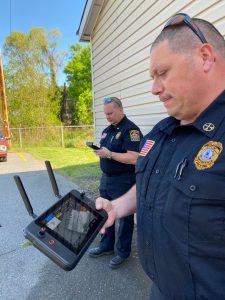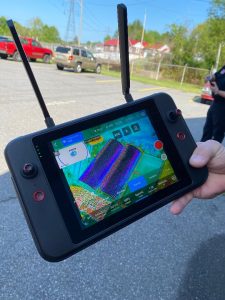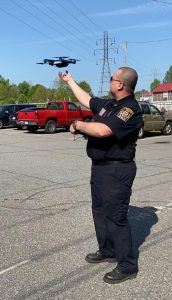By Callie Hietala

Since 2018, Martinsville’s fire department has been using some unexpected technology to help in their emergency response—drones. Now, the department has taken that program to the next level with the ability to send live drone feed to command units and other organizations, allowing more sets of eyes to assist in potentially life-saving operations.
Fire Marshall Andy Powers and Deputy Fire Chief Kris Shrader tested the new technology at the city’s water treatment plant on Monday. Shrader launched a drone into the air and watched the footage it sent back on a small screen held in his hand. The feed also was broadcast to a television screen set up in the back of a truck.
Fire Chief Ted Anderson, who also viewed the footage from another location, communicated with Shrader through the Microsoft Teams app, which allowed Shrader to share his screen.
“The implications for us now are, where we didn’t have a really good way to transmit it (drone footage) back to our command post or our emergency operations center, now we can put a drone in the air, set up a meeting through Teams,” and allow everyone in that meeting to see the drone footage in real time, Shrader said.
During large-scale events, crews set up an emergency operations center (EOC), and personnel develop strategies for handling the situation, he said.
“But during that time,” he explained, “we have to rely on folks in the field to give us clue on what’s going on, visually describe everything for us. In this case, I can put somebody out there, they can put this up in the air, and I can see what’s going on for the most part. It improves situational awareness for everybody involved.”

Powers showcased the abilities of one of the department’s two drones which was relaying thermal images to a handheld screen.
“It’s all based on thermal and it’s all relative,” Powers said, and explained if an object is hotter than its surroundings, it will show up on the screen as such.
“If I’m looking for a person in a field, that field’s been in the sun all day, so it could be one temperature,” he said, adding that “the person could be relatively hotter or colder than that field, making them stand out on the screen against their environment.”
Now that they have the ability to transmit the footage offsite, Powers said, “the police department can look at it in their office, we can look at it back at the fire station on a bigger screen. The bigger you can look at this, the better you can pick out what your objects are.”
One of the drones was programmed to use the water treatment building as a central point and consistently orbited around it. Such a program, he said, could be used in the case of a large structure fire. Emergency personnel could use the drone without having to constantly manipulate the controls, “and we could have live, real-time information of what’s happening in that fire. Because it’s thermal (imagery), you can look through smoke and see things that you wouldn’t be able to see normally.”
The drone program was Shrader’s brainchild, and he, along with Powers, are currently the city’s only certified pilots, though they are hoping more will complete the necessary training.

Operators must be Federal Aviation Administration (FAA) certified drone pilots “because we’re using it for emergency services, there are tons of rules that keep changing daily that we’re trying to keep up with and the easiest way to do that was to get certified,” Powers said.
The drone program itself is still in its infancy and comes with “tons of training and tons of trial and error,” he said, and added that in addition to being used in the city, the drones have been used to help other localities.
“We’ve had multiple requests for missing persons in Patrick County, and we’ve assisted them,” he said, adding that the drones were used last year when a hiker went missing from Primland, and on another occasion when someone had wandered into the woods. “Luckily, they were not in any danger,” he said of the latter instance, “the parents just didn’t know where they were.”
In both cases, while the drone did not actually locate the missing person, it was able to eliminate vast swaths of area and reduce the areas ground teams needed to search.
“We’ve been out several times after tornados for the National Weather Service,” Shrader said, flying over damaged areas, allowing the organization to analyze the footage and images to determine what weather event occurred, whether it was a tornado, straight line winds, or something else entirely.

Powers said it usually takes a team of three to handle a drone procedure safely and correctly. Besides the drone operator, staff also help with flight plans, monitoring the area, and vigilantly observing the operation.
While the drone can travel 4- to 5-miles away from its operator, Powers said current FAA regulations require that it remain in sight of the team, which is about 16-18,000 feet. Some rule changes expected from the FAA may alter that requirement, he added.
However, even if the current rules remain in place, the new technology now being implemented to transmit drone footage to remote locations in real-time will help local emergency personnel to operate and communicate more effectively when needed.



